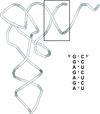issue contents
November 2007 issue

Cover illustration: Enzymatic product traffic in Torpedo californica acetylcholinesterase was studied by combining temperature-controlled kinetic crystallography and cryophotolysis of `caged' arsenocholine. The conformational changes observed increased the active-site gorge volume and opened an alternative `backdoor' exit (p. 1115).
research papers
A kinetic crystallography strategy aimed at structurally addressing the issue of product traffic in acetylcholinesterase is presented in which UV-laser-induced cleavage of a photolabile precursor of the enzymatic product analogue arsenocholine, `caged' arsenocholine, is performed in a temperature-controlled X-ray crystallography regime.
A statistical model that takes experimental errors into account allows improved estimates of the twinning fraction in merohedrally (or pseudo-merohedrally) twinned macromolecular crystals.
X-ray diffraction reflection profiles from crystals of E. coli β-galactosidase that were repeatedly cycled between 100 K and room temperature were measured at both temperatures. Domain analysis showed cooling-induced crystal damage that recovered to a large degree with warming, although there were irreversible effects, primarily from radiation exposure.
The crystal structure of a serine-specific tRNA acceptor-stem microhelix, the binding site for the seryl-tRNA synthetase, was solved by X-ray analysis.
PDB reference: tRNASer acceptor stem, 2v6w, r2v6wsf
Conformation families were determined for dipeptidic, tripeptidic, tetrapeptidic and pentapeptidic fragments. Statistical weights were calculated for the conformation families.
Y. pestis 6-hydroxymethyl-7,8-dihydropterin pyrophosphokinase (HPPK) has been characterized both structurally and biochemically.
PDB reference: Y. pestis HPPK, 2qx0, r2qx0sf
The complete structure (including H atoms) of photoactive yellow protein has been determined in D2O-soaked crystals through the application of joint X-ray (1.1 Å) and neutron (2.5 Å) structure refinement in combination with cross-validated maximum-likelihood simulated annealing.
PDB reference: photoactive yellow protein, 2qws, r2qwssf
This manuscript describes the first structures of ABC transport-system components from the pathogenic bacterium Y. pestis. These structures have allowed a comparison of the interactions between periplasmic binding proteins and their cognate transmembrane domains.
short communications
Open  access
access
 access
accessModelling deformation electron density using interatomic scatters is simpler than multipolar methods, produces comparable results at subatomic resolution and can easily be applied to macromolecules.
A crystal structure of SHP-corepressor-derived LxxLL-like motif with androgen receptor (AR) ligand binding domain reveals the details of SHP-AR interaction.
PDB reference: AR LBD with SHP peptide NR Box 2, 2z4j, r2z4jsf


 journal menu
journal menu


























